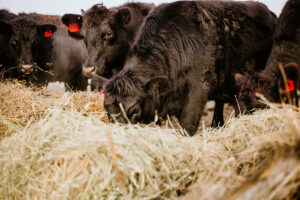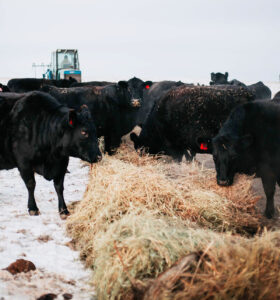Feeding Decisions Are Important Breeding Decisions
This article written by Dr. Reynold Bergen, BCRC Science Director, originally appeared in the December 2021 issue of Canadian Cattlemen magazine and is reprinted on the BCRC Blog with permission of the publisher.

When life gets really stressful it can be hard to remember what you already know. This column probably won’t tell you anything new, but it might remind you of some important principles that can get overlooked in the scramble to buy feed and make important financial decisions. Winter feed costs are a key financial make-or-break factor for cow-calf producers, especially this winter. Weaned calf sales bear most of the responsibility for offsetting those winter feed costs, so reproductive performance is another financial make-or-break factor. The most profitable cows are those that wean a calf every year for the greatest number of years.
The big challenge is that feed costs and reproductive performance are inseparable. Drastic measures to minimize per head feed costs usually have a negative impact on reproductive performance. Maximizing reproductive performance can increase feed costs significantly. But there can be some room to move in the middle. Maintaining or even improving reproductive performance can often be achieved by carefully managing the feed you have to maintain optimal body condition scores. This may mean spending money differently, not necessarily more of it, and will help maintain or improve reproductive performance.
Cows are likely thinner than usual this fall, even if their calves were weaned early due to drought. While there are exceptions to every rule, reproductive problems are usually more common with thin cows than cows in optimal body condition.
Thin cows are more likely to have difficulty calving. Even if they don’t require (or receive) calving assistance, their calves will likely be slower to stand and nurse. They may also nurse less and consume less colostrum soon after birth. Colostrum from thin cows contains less fat, energy, and antibodies than colostrum from cows in optimal body condition. All calves are born with an immature immune system, so colostrum is critical to helping the calf fend off disease for the first few weeks of life. This means that calves born to thin cows will have a tougher start in life, will be more likely to get sick, may be less likely to survive until weaning, and may not grow as rapidly or efficiently as calves born to dams with good body condition score.

Cows that are thin at calving will take longer to start cycling again and will take longer to rebreed in 2022. This means they will calve later and wean lighter calves in the fall of 2023, especially if feed shortages and quality issues persist into the 2022 breeding season. Short-changing cows can be costly in the long run.
So What Does This Mean… to Me?
Using feed resources more strategically can reduce feed costs while reducing the risk that pregnant cows will be nutritionally short-changed. Winter feed and supplements aren’t just costly this year, they’re also simply hard to find. This has led many producers to search for and lock in whatever winter feeds and supplements they can find, from all sorts of failed crop greenfeed, to a wide assortment of crop residues, to all manner of screenings, to distillers’ grains, to more straw than usual.
This is a good year to start working with a nutritionist if you aren’t already. Get your feeds tested to find out what’s in there. Even the feeds you’ve grown or used before will have a different nutrient content due to poor growing conditions. Your nutritionist can tell you what toxins to be aware of and test for, and how to handle them. They can tell you how to optimally combine your various feeds to dilute toxins to safe levels, while meeting the cow’s nutrient requirements at different stages of pregnancy. Feed testing costs money, and so will a nutritionist. But they will likely cost less than an abortion storm due to an unexpected toxin, calf death losses, or a significantly delayed or prolonged (re)breeding and calving season because energy and other nutrient requirements were not met.
Cows’ nutritional demands will increase as winter proceeds because the fetal calf’s nutrient demands increase. The winter feed and supplement supply will shrink at the same time. This happens every year, but this year’s margin for error is much narrower than usual. If the winter is abnormally cold, that feed will be used up even faster. If winter is prolonged, or if snow is minimal and the spring is dry, feed may run low before pasture is ready. You’ve likely already pregnancy checked and culled the opens, and those with poor bags, poor feet, miserable temperaments and the other obvious candidates. But if your preg-checker estimated how many days pregnant they are (and you recorded that), this may be an opportunity to tighten up next spring’s calving season. If feed supplies get worryingly low as winter unfolds, use your preg-checking records to identify the late calvers; they may be the first ones you consider selling to preserve enough feed for the rest.
Managing cow nutrition to optimize reproductive performance should be a key priority every year for cow-calf producers. This year squeezing as much as you can from the feed you have could well be critical. Your www.beefresearch.ca website contains a variety of decision-making tools and other resources to help you navigate some of these tough winter feeding and other management decisions.
BCRC Tools & Calculators:
- Winter Feed Cost Comparison Calculator
- Body Condition Scoring Tool
- Tool for Evaluating Feed Test Results
- Value of Calving Distribution Calculator
Other Resources:
- A Prolonged Calving Season Can Be Costly (BCRC post)
- Distillers’ Grains (BCRC webpage)
- Mycotoxins (BCRC webpage)
- Alternative Feeds (BCRC webpage)
- Factors Affecting Nutrient Requirements (BCRC webpage)
- Nutrient Requirements for Pregnant Cows and Bred Heifers (BCRC chart)
The Beef Cattle Research Council is funded by the Canadian Beef Cattle Check-Off. The BCRC partners with Agriculture and Agri-Food Canada, provincial beef industry groups and governments to advance research and technology transfer supporting the Canadian beef industry’s vision to be recognized as a preferred supplier of healthy, high quality beef, cattle and genetics.
Click here to subscribe to the BCRC Blog and receive email notifications when new content is posted.
The sharing or reprinting of BCRC Blog articles is typically welcome and encouraged, however this article requires permission of the original publisher.
We welcome your questions, comments and suggestions. Contact us directly or generate public discussion by posting your thoughts below.